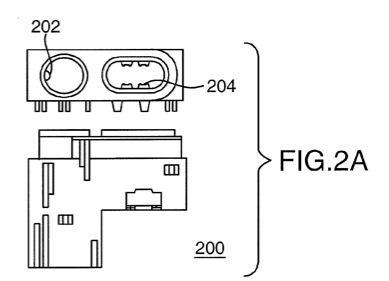Two new Apple patents (number 20100312932 and 20100312931) at the US Patent & Trademark Office show that Apple is working to make it easier to connect iOS devices to peripherals. The patents relate to connector interfaces and more particularly to a connector interface system that’s utilized in conjunction with media players and their accessories.
The patent are for an interface and protocol to allow a media player to communicate with external accessories over a transport link. The protocol includes a core protocol functionality and a number of accessory lingoes. Examples of accessory lingoes include a microphone lingo, a simple remote lingo, a display remote lingo, an RF transmitter lingo, and an extended interface lingo.
The inventors on both patents are Emily C. Schubert, Wang Chun Leung, Gregory T. Lydon, Scott Krueger, Paul Holden, John Archibald, Lawrence G. Bolton, Donald J. Novotney, John B. Filson and David Tupman.
A media player stores media assets, such as audio tracks or photos, that can be played or displayed on the media player. One example of a media player is the iPod.RTM. media player, which is available from Apple Computer, Inc., of Cupertino, Calif. Often, a media player acquires its media assets from a host computer that serves to enable a user to manage media assets. As an example, the host computer can execute a media management application to manage media assets. One example of a media management application is iTunes.RTM., version 6.0, produced by Apple Computer, Inc.
]A media player typically includes one or more connectors or ports that can be used to interface to the media player. For example, the connector or port can enable the media player to couple to a host computer, be inserted into a docking system, or receive an accessory device. There are today many different types of accessory devices that can interconnect to the media player. \
For example, a remote control can be connected to the connector or port to allow the user to remotely control the media player. As another example, an automobile can include a connector and the media player can be inserted onto the connector such that an automobile media system can interact with the media player, thereby allowing the media content on the media player to be played within the automobile.
Currently, the connectors or ports of a media player are open for use so long as a compatible connector or port is utilized. Consequently, Apple says numerous third-parties have developed accessory devices for use with other manufacturers’ media players.
In a typical connector interface, there’s a docking connector that allows for the docking of the media player device to a docking station for another type of communication for the device. A media player also typically includes a remote connector with the ability to output audio. As more multi-media content becomes available (i.e., digital, video graphics, etc.) it is desirable to have a media player which can effectively input and output such data.
Finally, Apple says, a media player must be able to identify a particular device’s functionality to which it is associated. So far, there’s no device that includes features that overcome many of the above-stated problems. What’s desired is a connector interface system which is utilized in such a device to address all the above-identified issues, and Apple says the invention addresses such a need.
Here’s Apple’s summary of the invention: “A connector interface system is disclosed. The connector interface system includes an interface and a protocol in communication with the interface which allows a media player to communicate with external devices over a transport link. The protocol includes a core protocol functionality and a plurality of accessory lingoes. The accessory lingoes comprise a microphone lingo, a simple remote lingo, a display remote lingo, a RF transmitter lingo and an extended interface lingo.”
— Dennis Sellers

